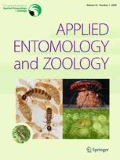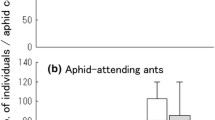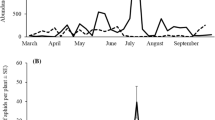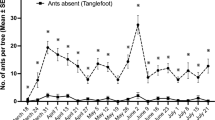Abstract
An aphidophagous ladybird, Platynaspidius maculosus (Weise) (Coleoptera: Coccinellidae), is originally distributed in China, Taiwan, and Vietnam. The ladybird has recently intruded into the southern and central parts of Japan. The present study found that the larvae of this ladybird preyed on three aphid species, Aphis spiraecola, Aphis gossypii, and Toxoptera citricidus (all Hemiptera: Aphididae), feeding on young shoots of various Citrus species in August to early October in Shizuoka Prefecture, central Japan. Laboratory rearing of the sampled larvae confirmed that the larvae completed their development (adult emergence) by consuming each of the three aphid species. The ladybird larvae were observed foraging in aphid colonies attended by one of the four ants, Lasius japonicus, Pristomyrmex punctatus, Formica japonica, and Camponotus japonicus (all Hymenoptera: Formicidae). Field observations revealed that the foraging/feeding larvae were almost completely ignored by honeydew-collecting ants even when they physically contacted each other. Thus, in Japan, the larvae of the exotic ladybird exploit colonies of the three aphid species attended by one of the four ant species on many Citrus species. On the basis of the results, I discuss the possibility of the ladybird’s reproduction on citrus trees in Japan, probable adaptations of the ladybird larvae to aphid-attending ants, and potential impacts of the ladybird on native insect enemies attacking ant-attended aphids on citrus.
Similar content being viewed by others
References
Akino T, Yamaoka R (1998) Chemical mimicry in the root aphid parasitoid Paralipsis eikoae Yasumatsu (Hymenoptera: Aphidiidae) of the aphid-attending ant Lasius sakagamii Yamauchi & Hayashida (Hymenoptera: Formicidae). Chemoecology 8:153–161
Brown PMJ, Frost R, Doberski J, Sparks T, Harrington R, Roy HE (2011) Decline in native ladybirds in response to the arrival of Harmonia axyridis: early evidence from England. Ecol Entomol 36:231–240
Elliott N, Kieckhefer R, Kauffman W (1996) Effects of an invading coccinellid on native coccinellids in an agricultural landscape. Oecologia 105:537–544
Elton CS (1958) The ecology of invasions by animals and plants. Methuen, London
Evans EW (2004) Habitat displacement of North American ladybirds by an introduced species. Ecology 85:637–647
Imasaka S (2006) New record of Platynaspidius maculosus from Kyushu Island in Japan. Gekkan-Mushi 425:45 (in Japanese)
Ishikawa H (2011) New record of Platynaspidius maculosus from Shizuoka Prefecture in Japan. Gekkan-Mushi 487:46 (in Japanese)
Kaneko S (2002) Aphid-attending ants increase the number of emerging adults of the aphid’s primary parasitoid and hyperparasitoids by repelling intraguild predators. Entomol Sci 5:131–146
Kaneko S (2003a) Different impacts of two species of aphid-attending ants with different aggressiveness on the number of emerging adults of the aphid’s primary parasitoid and hyperparasitoids. Ecol Res 18:199–212
Kaneko S (2003b) Impacts of two ants, Lasius niger and Pristomyrmex pungens (Hymenoptera: Formicidae), attending the brown citrus aphid, Toxoptera citricidus (Homoptera: Aphididae), on the parasitism of the aphid by the primary parasitoid, Lysiphlebus japonicus (Hymenoptera: Aphidiidae), and its larval survival. Appl Entomol Zool 38:347–357
Kaneko S (2007a) Larvae of two ladybirds, Phymatosternus lewisii and Scymnus posticalis (Coleoptera: Coccinellidae), exploiting colonies of the brown citrus aphid Toxoptera citricidus (Homoptera: Aphididae) attended by the ant Pristomyrmex pungens (Hymenoptera: Formicidae). Appl Entomol Zool 42:181–187
Kaneko S (2007b) Predator and parasitoid attacking ant-attended aphids: effects of predator presence and attending ant species on emerging parasitoid numbers. Ecol Res 22:451–458
Kaneko S (2013) Occurrence of the exotic predatory ladybird Platynaspidius maculosus (Coleoptera: Coccinellidae) in citrus groves in Shizuoka City, Central Japan: seasonal prevalence of adults captured on sticky traps. Appl Entomol Zool 48:189–194
Kido K (2010) Overwintering by Platynaspidius maculosus in Fukuoka Prefecture in Japan. Gekkan-Mushi 475:47 (in Japanese)
Korenaga R, Koizumi M, Ushiyama K, Furuhashi K (1992) A handbook of diseases and insect pests of fruit trees, vol 1. Citrus, loquat, and kiwifruit. Japan Plant Protection Association, Tokyo (in Japanese)
Kusakabe Y (2013) New record of Platynaspidius maculosus from Kanagawa Prefecture in Japan. Sayabane New Ser 12:59 (in Japanese)
Liepert C, Dettner K (1993) Recognition of aphid parasitoids by honeydew-collecting ants: the role of cuticular lipids in a chemical mimicry system. J Chem Ecol 19:2143–2153
Mack RN, Simberloff D, Lonsdale WM, Evans H, Clout M, Bazzaz FA (2000) Biotic invasions: causes, epidemiology, global consequences, and control. Ecol Appl 10:689–710
Matsubara Y, Ueno T, Sasaji H (1998) Platynaspidius maculosus found in Okinawa Island: new record from Japan. Gekkan-Mushi 332:38 (in Japanese)
Moritsu M (1983) Aphids of Japan in colors. Zenkoku Noson Kyoiku Kyokai, Tokyo (in Japanese)
Sasaji H (1992) Descriptions of four coccinellid larvae of Formosa, with the phylogenetic importance (Coleoptera: Coccinellidae). Memo Facul Educ Fukui Univ Ser II (Nat Sci) 42:1–11
Sasaji H (1998) Natural history of the ladybirds. University of Tokyo Press, Tokyo (in Japanese)
Sasaji H, Taniguchi M (2003) New record of Platynaspidius maculosus (Weise, 1910) from Japan. Gekkan-Mushi 391:13 (in Japanese)
Tao C, Chiu SC (1971) Biological control of citrus, vegetables and tobacco aphids. Taiwan Agricultural Research Institute Special Publication No. 10
Völkl W (1995) Behavioral and morphological adaptations of the coccinellid Platynaspis luteorubra for exploiting ant-attended resources (Coleoptera: Coccinellidae). J Insect Behav 8:653–670
Völkl W, Liepert C, Birnbach R, Hübner G, Dettner K (1996) Chemical and tactile communication between the root aphid parasitoid Paralipsis enervis and trophobiotic ants: consequences for parasitoid survival. Experientia 52:731–738
Williamson M (1996) Biological invasions. Chapman and Hall, London
Author information
Authors and Affiliations
Corresponding author
Rights and permissions
About this article
Cite this article
Kaneko, S. Larvae of the exotic predatory ladybird Platynaspidius maculosus (Coleoptera: Coccinellidae) on citrus trees: prey aphid species and behavioral interactions with aphid-attending ants in Japan. Appl Entomol Zool 53, 85–91 (2018). https://doi.org/10.1007/s13355-017-0531-y
Received:
Accepted:
Published:
Issue Date:
DOI: https://doi.org/10.1007/s13355-017-0531-y




